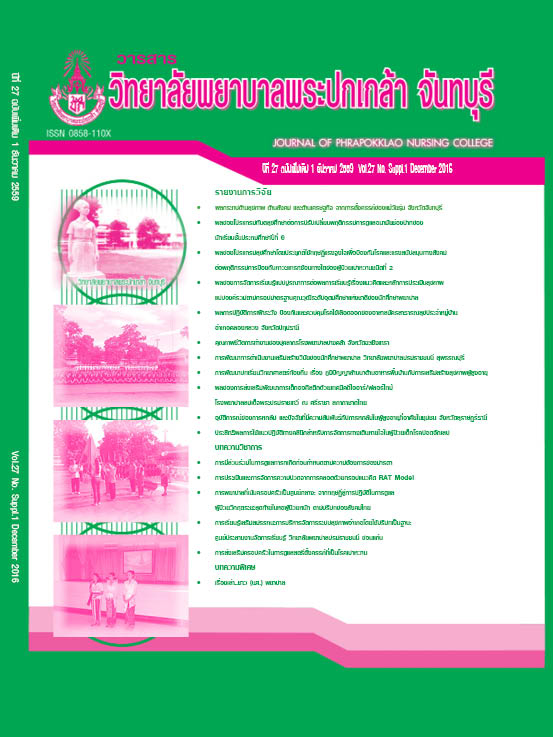Family-centered Care: From Theory to Practice for End of Life Care of Critical Patients in Intensive Care Unit based on Thai Context
Keywords:
-Abstract
-
References
จันทิมา ชินสร้อย. (2550). ผลของโปรแกรมการดูแลผู้คลอดที่เน้นครอบครัวเป็นศูนย์กลางต่อความพึงพอใจในบริการของผู้คลอดและครอบครัว และสัมพันธภาพของคู่สมรส (วิทยานิพนธ์ปริญญามหาบัณฑิต). ชลบุรี: มหาวิทยาลัยบูรพา.
ปฐมวดี สิงห์ดง, และชนกพร จิตปัญญา. (2555). ประสบการณ์ของสมาชิกครอบครัวในหอผู้ป่วยวิกฤต: การวิจัยเชิงคุณภาพ. รามาธิบดีพยาบาลสาร, 18(3), 404-417.
พัชรี หมื่นกล้าหาญ. (2545). ผลการดูแลผู้ป่วยอุบัติเหตุโดยเน้นครอบครัวเป็นศูนย์กลางต่อความพึงพอใจของผู้ป่วยและครอบครัวและความมั่นใจของครอบครัวในการดูแลผู้ป่วย (วิทยานิพนธ์ปริญญามหาบัณฑิต). ชลบุรี: มหาวิทยาลัยบูรพา.
รัชนี นามจันทรา. (2552). การดูแลที่เน้นผู้ป่วยและครอบครัวเป็นศูนย์กลาง: รูปแบบการบริการสุขภาพที่ท้าทาย. วารสารสภาการพยาบาล, 24(1), 5-10.
สุจิตรา ลิ้มอำนวยลาภ, และชวนพิศ ทำนอง. (2550). การพยาบาลผู้ป่วยที่มีภาวะเจ็บป่วยวิกฤต: Critical care nursing. ขอนแก่น: คณะพยาบาลศาสตร์ มหาวิทยาลัยขอนแก่น. (เอกสารอัดสำเนา).
สุนิศา สุขตระกูล. (2544). ความต้องการในภาวะสูญเสียและเศร้าโศกของสมาชิกในครอบครัวผู้ป่วยภาวะใกล้ตาย (วิทยานิพนธ์ปริญญามหาบัณฑิต). มหาวิทยาลัยเชียงใหม่.
สุริยา ฟองเกิด, และอนิสา อรัญคีรี. (2556). การสร้างเสริมสุขภาพครอบครัว. ชลบุรี: ศรีศิลปการพิมพ์.
สุริยา ฟองเกิด, วรรณี เดียวอิศเรศ, และจินตนา วัชรสินธุ์. (2554). ทัศนคติของพยาบาลต่อการให้ความสำคัญของครอบครัวในการพยาบาล: การสำรวจในพยาบาลวิชาชีพที่สำเร็จการศึกษาจากวิทยาลัยพยาบาลบรมราชชนนี ชลบุรี. ใน รายงานสืบเนื่องการประชุมวิชาการระดับชาติ เรื่อง บทบาทของสถาบันการศึกษาพยาบาลเพื่อรองรับประชาคมอาเซียน. หน้า 1-15. วันที่ 16 ธันวาคม 2554 ณ โรงพยาบาลเซนต์หลุยส์.
อัญชัน เตชะวีรากร. (2544). ผลของการใช้รูปแบบการดูแลทารกที่ยึดครอบครัวเป็นศูนย์กลางตามทฤษฎีการพยาบาลของคิงต่อการบริการพยาบาลตามการรับรู้ของผู้ดูแลและพยาบาลวิชาชีพ (วิทยานิพนธ์ปริญญามหาบัณฑิต). ชลบุรี: มหาวิทยาลัยบูรพา.
Agard, A. S., & Harder, I. (2007). Relatives’ experiences in intensive care--Finding a place in a world of uncertainty. Intensive and Critical Care Nursing, 23(3), 170-177.
Carter, P. A., & Clark, A. P. (2005). Assessing and treating sleep problems in family caregivers of intensive care unit patients. Critical Care Nurse, 25(1), 16, 18-23.
Coker, T. R., Rodriguez, M. A., & Flores, G. (2010). Family-centered care for US children with special health care needs: Who gets it and why?. Pediatrics, 125(6), 1159-1167.
Eggenberger, S. K., & Nelms, T. P. (2007). Being family: The family experience when an adult member is hospitalized with a critical illness. Journal of Clinical Nursing, 16(9), 1618-1628.
Galvin, E., et al. (2000). Challenging the precepts of family-centered care: Testing a philosophy. Pediatric Nursing, 26(6), 625-632.
Gries, C. J., Curtis, J. R., Wall, R. J., & Engelberg, R. A. (2008). Family member satisfaction with end-of-life decision making in the ICU. Chest, 133(3), 704-712.
Johnson, B. H. (2000). Family-centered care: Four decades of progress. Families, Systems, & Health, 18(2), 137-156.
May, K. A., & Mahlmeister, L. R. (1990). Comprehensive maternity nursing: Nursing process and the childbearing family (2nd ed.). Philadelphia: J. B. Lippincott.
McAdam, J. L., Arai, S., & Puntillo, K. A. (2008). Unrecognized contributions of families in the intensive care unit. Intensive Care Medicine, 34(6), 1097-1101.
Phillips, C. R. (1999). Family-centered maternity care: Past, present, future. International Journal of Childbirth Education, 14(4), 6-11.
Pryzby, B. J. (2005). Effects of nurse caring behaviours on family stress responses in critical care. Intensive and Critical Care Nursing, 21(1), 16-23.
Wall, R. J. (2009). The one thing certain in the ICU is uncertainty. Critical Care Alert, 17(2), 9-16.
Wright, L. M., & Bell, J. M. (2009). Beliefs and illness: A model for healing. Calgary, AB: 4th Floor Press.
Yang, S. (2008). A mixed methods study on the needs of Korean families in the intensive care unit. Australian Journal of Advanced Nursing, 25(4), 79-86.
Downloads
Published
How to Cite
Issue
Section
License
Copyright (c) 2016 Journal of Phrapokklao Nursing College

This work is licensed under a Creative Commons Attribution-NonCommercial-NoDerivatives 4.0 International License.
เนื้อความ ข้อมูล และรายการอ้างอิงที่ผู้เขียนใช้ในการเขียนบทความเพื่อลงตีพิมพ์ในวารสารวิทยาลัยพยาบาลพระปกเกล้า จันทบุรี ถือเป็นความคิดเห็นและความรับผิดชอบของผู้เขียน คณะผู้จัดทำวารสารไม่จำเป็นต้องเห็นพ้องด้วยหรือร่วมรับผิดชอบ
บทความที่ได้รับการลงตีพิมพ์ในวารสารวิทยาลัยพยาบาลพระปกเกล้า จันทบุรี ถือเป็นลิขสิทธิ์ของวารสารวิทยาลัยพยาบาลพระปกเกล้า จันทบุรี หากหน่วยงานหรือบุคคลใดต้องการนำส่วนหนึ่งหรือทั้งหมดของบทความไปเผยแพร่ต่อเพื่อวัตถุประสงค์ใด ๆ จะต้องได้รับอนุญาตจากบรรณาธิการวารสารก่อน



